François Certain de Canrobert
François Marcellin Certain de Canrobert (born François Certain Canrobert;[2] 27 June 1809 – 28 January 1895) was a French Marshal. He demonstrated ability during the Second French Empire while participating in the Battle of Alma, the Battle of Magenta, the Battle of Solferino and the Battle of Gravelotte. A staunch supporter of Napoleon III, he became, under the French Third Republic, one of the leading figures in the Bonapartist party (French: parti bonapartiste) and chairman, from 1876 to 1894, of the Senate (French: Sénat) within the French parliamentary group "Call upon the people" (French: Appel au peuple).
François Certain de Canrobert | |
|---|---|
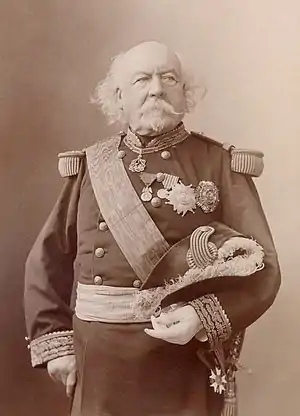 François Certain de Canrobert photographed by Nadar | |
| Nickname(s) | Doyen[1] of Marshals Doyen des Maréchaux |
| Born | 27 June 1809 Saint-Céré, France |
| Died | 28 January 1895 (aged 85) Paris, France |
| Allegiance | |
| Service/ | French Army Line Infantry |
| Years of service | 1828–1873 |
| Rank | Maréchal de France |
| Commands held | Subdivision of Batna 2nd Foreign Legion Regiment 2ème R.E.L.E (1848) VI Army Corps, Army of the Rhine (1870) |
| Battles/wars | Conquest of Algeria Crimean War Franco-Prussian War |
| Other work | Military governor of Paris (1865–1870) Senator of Lot (1876) Senator of Charente (1879) |
Biography
Family Origins
François Certain de Canrobert was born in Saint-Céré in Lot, where a statue (1897) in his effigy was erected in place de la République due to Alfred Lenoir.
At his birth, his Father, Antoine Certain Canrobert, former captain, was already 55 years old. This officer of the Ancien Regime had emigrated in 1791 and served in the Armée de Condé (French: armée de Condé). His half-brother, Antoine, a brilliant officer issued from Saint-Cyr, was killed by a cannonball at the Battle of Ligny (French: Fleurus) on June 16, 1815, while combating for Emperor Napoleon I.
Through his father’s sister, Marie-Louise, he was the cousin of Adolphe and Marcellin Marbot, who became respectively maréchal de camp (général de brigade) and lieutenant-général (général de division) during the July Monarchy.
Military career
Aged 17, Canrobert entered on November 19, 1826, to the École Royale spéciale militaire de Saint-Cyr where he was designated as a caporal (corporal) on May 18, 1828. At his sortie, he integrated the 47th Line Infantry Regiment (French: 47e Régiment d’Infanterie de Ligne) (RIL), with the rank of Sous-lieutenant starting October 1. He served until 1840 and was promoted to lieutenant on January 20, 1832.
North Africa
In 1835, he arrived with his unit in Algeria where he engaged in combat on the edges of Oued Sig and Habra. In 1836, he fought in actions at Dar el Achen, Tafna, Sidi Yacoub, La Silal and Bet el Laham.
He was designated as Lieutenant Adjudant Major, on September 28, 1836. On April 26, 1837, he was promoted to captain and occupied the function of Captain Adjudant Major. He took part in the combat of Medjeoly-Amar and the Siege of Constantine (French: Siège de Constantine) where, as an assistant to colonel Michel Combes (French: Combes), he was wounded, Thus, at the age of 27, Canrobert earned the Knight Cross of the Legion d'honneur.
He was assigned to the 6th Chasseurs Battalion à Pied (French: 6e Bataillon), on October 17, 1840. He took part in the battle of col de Mouzaïa in 1840 (French: col de la Mouzaïa). In the following year, he participated in actions at de Nador, de Moursia and confronted the Flittas. Designated as chef de bataillon (commandant – major) on May 22, 1842, he joined the 13th Light Infantry Regiment (French: 13e Régiment d'Infanterie Légère). On October 16, he passed to the 5th Chasseurs Battalion à Pied (French: 5e Bataillon de Chasseurs à Pied), where he gained the Officer Order of the Legion d'honneur while demonstrating combat capability at Gontas, Baal, Tadjena, Battle of Sidi Brahim (French: Sidi-Brahim), then near Oued Lemig, during the combat Isly and at Riou.
Promoted lieutenant-colonel, on October 26, 1845, he was assigned to the 16th Line Infantry Regiment (French: 16e RIL), on September 4. On June 8, 1847, he was assigned to the 2nd Line Infantry Regiment (French: 2e RIL) and commanded the subdivision of Batna.
Passage to the Legion
Promoted to colonel, on November 8, he was assigned to the 78th Line Infantry Regiment (French: 3e Régiment d’Infanterie Légère) which he left on March 31, 1848, to take the functions of regimental commander of the 2nd Foreign Legion Regiment 2ème R.E.L.E, while simultaneously maintaining the subdivision of Batna. With this unit, he took on Ahmed Bey (French: bey Achmed).
In June, he substituted for colonel Jean-François de Cariés de Senilhes (French: Cariés de Senilhes) and took command of the 3rd Zouaves Regiment (French: 3e Régiment de Zouaves) and the subdivision of Sour El-Ghozlane. In 1849, he was in Beni Mélikech, Sameur, Al Amri. Then, he commanded at the battle of Zaatcha (French: siège de Zaatcha). He accordingly earned the Commander Neck Order of the Legion d'honneur on December 10.
General of the Second Empire
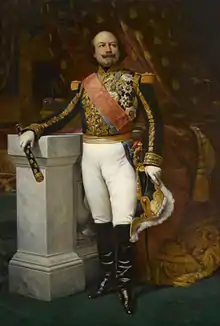
Recalled to France by the Prince-President Louis-Napoléon Bonaparte, he was designated as maréchal de camp (général de brigade) starting January 12, 1850. He was nominated as commandant of the infantry brigade of the 1st Division of Paris, on March 8, 1850, then the command of the 3rd Brigade, on February 9, 1851, and contributed to the success in Paris of the French coup d'état of 1851. In the afternoon of December 4, 1851, on the Boulevards Montmarte and Poissonnière, the soldiers of the Division commanded by Canrobert came in contact with a crowd formed of the curious and protestors[3] · .[4] In a certain confusion, the soldiers opened fire. The carnage resulted in a hundred to 300 dead as well as hundreds of wounded,[3] however on the night of December 4, the Parisian resistance at the coup were done with. The result then, was 300 to 400 persons killed without counting the soldiers.[5] While the protestors were formed in 2/3 of workers, amongst them also featured the innocent and curious, victims of the division of Canrobert on the grand boulevards.[5] In all France, 26,884 people were arrested, essentially in the South-East, the South-West and a couple of departments in the Center. Almost 21,000 people were condemned by mixed commissions (composed in each department by prefects, a general, and a magistrate) out of which 9,530 were in transportation to Algeria and 239 were sent to Cayenne in Guiana. On another hand and quite quickly, all pronounced repression measures declared by the 82 mixed commissions worried President Louis-Napoléon Bonaparte[6] who delegated in extraordinary mission, generals Canrobert, Espinasse, and State Council Quentin Bauchart, in order to revise the arrests decisions taken and prepare acts of grâce (forgiving the condemned by mercy). Espinasse and Canrobert, were charged with the South-West and Languedoc, showing proof of little indulgence towards the condemned, they both accorded a little more than a thousand acts of forgiveness, while State Counselor Quentin-Bauchart, charged of the South-East, accorded alone 3,400 forgiveness sentences, while Louis-Napoléon Bonaparte applied in his right also equally from his side the forgiving of numerous condemnations.[7]
Canrobert cumulated accordingly following these events, the function of aide de camp to the Prince-President, then the Emperor. Promoted Général de division, on January 14, 1853, he commanded the infantry division at camp Helfaut-Saint Omer, as of April 27. In May, he became the inspector general of the 5th Infantry Arrondissement for the year 1853 before being designated to the infantry division of the Orient Army, on February 23, 1854.
Crimea
As Général de division, he participated to the Crimean War and became commander in chief after Marshal Saint-Arnaud. He took part in action at Dobrduja and the Battle of Alma, where he was slightly wounded. He was elevated to the Grand Officer Order of the Legion d'honneur on October 1. Present at the Battle of Balaclava and the Battle of Inkerman, he was wounded during the course of the latter, on November 5, 1854. He was accordingly promoted to the Order of the Grand-Croix of the Légion d'honneur. On January 13, 1855, he received the Medaille Militaire.
Judged too timorous, he was relieved by general Aimable Pélissier. He, accordingly, reassumed command of his former division, which became the 1st Infantry Division of the 2nd Corps. This situation having become difficult, Napoleon III insisted that he return to France. After several refusals, in August, Canrobert returned to Paris to take up his functions as aide de camp.
His disputes with Lord Raglan, general of the British Army, obliged him to relinquish his command. On March 18, 1856, he was elevated to the dignity of Marshal of France.
Italy
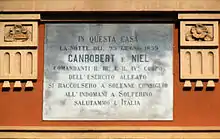
In February 1858, he commanded the division of the East, at Nancy, then the Camp de Châlons, starting from June 1, 1858. On April 22, 1859, he received the command of the 3rd Army Corps of the Alpes and participated in the campaign of Italy from April to July, passing by Turin, Dorial, Balba, Magenta and Solferino. He distinguished himself during the Battle of Magenta (June 4, 1859) and was a major contribor to the victory at the Battle of Solferino on June 24, 1859.
France

He then joined the garrison at Nancy with his army corps. He became commandant of the 3rd Military Arrondissement at Nancy, on August 27. In 1862, he commanded the troops of the Camp de Châlons, then took command of the 4th Army Corps at Lyon, starting in October. On June 22, 1856, he commanded the 1st Army Corps of the 1st Military Division of Paris.
1870-1871
On August 12, he refused to take command of the Army of the Rhine, petrified by the responsibilities which would ensue, abandoned this vicious command to Bazaine and became an obeying subordinate. He partook to the combats of Sainte-Barbe, Noisseville and Landonchamps. On August 16/18, he commanded the 6th Army Corps and distinguished capability at Gravelotte, Saint-Privat where he shook three corps of général von Steinmetz and decimated the 1st Infantry Regiment of the Prussian Guard (French: garde royale prussienne), however, due to a mistake in supply of ammunition and reinforcements, he abandoned his position. He was made prisoner with Marshal Bazaine during the surrender of Metz on October 28, 1870. Following several months in captivity, he was liberated at and regained France in March 1871.
End of his military career and political career
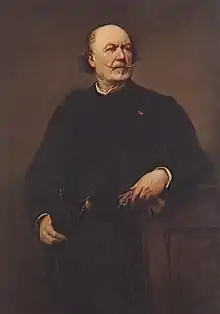
He was accordingly designated as President of the advancing commission of the infantry then member of the Conseil supérieur de la guerre in 1872, member of the defense committee in 1873. He led a political career in "Call upon the people" group (French: Appel au people), while being elected as Senator of Lot in 1876, the Senator of Charente in 1879, a function which he held until 1894. His colleague Victor Hugo, would not be tender for him: « J'ai vu Canrobert au Sénat. Caboche de reître. Méchant, mais bête (Victor Hugo :"I saw Canrobert in the Senate. Full of Cavaliering. Mean but silly.[8]
Close to President-Marshal Duke de Mac Mahon, he voted, in June 1877, for the dissolution of the Chamber and supported the Government of Albert de Broglie (French: ministère Broglie-Fourtou). In 1873, he represented the French Government at the funeral of King Victor Emmanuel II. A marking figure of the Bonapartist Party, his participation to the political debates were mainly axed on military issues. He voted in general on the conservative side, most notably against law projects on education, against judicial reforms, against the expulsion of princes or against divorce, abstaining on the reestablishment of the voting arrondissement or the restricted law project of the freedom of the press.
Doyen[1] of the Marshals of France of his époque, he attended the funeral of President-Marshal Duke de Mac-Mahon and was saluted by Russian Admiral Avellane on behalf of the Russian Emperor (French: Empereur de Russie). This was his last public official appearance. He died in his Parisian home, on January 28, 1895. His funeral was celebrated on Sunday February 3, 1895 at the Church of Saint-Louis-des-Invalides where he was buried. Amiral Henri Rieunier, Ministère de la Marine, was designated to hold one of the five cordons of the funeral chariot.
He was the owner of the Eglantine Castle, which houses since 1991 the Musée de la toile de Jouy.
Honors and posterity
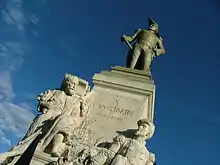
The name of Canrobert was given to:
- From 1872 to 1956, the village of Ange-Gardien, in the comté de Rouville, in Quebec; a rang of the municipality commemorates still the Battle of Magenta, where he distinguished himself;
- A garrison at Pontoise, then the area lot of the Pontoise station and the street that serves it;
- The place in the village of Saint-Privat-la-Montagne, near the cemetery in which the battle took place;
- A city in the Constantine Department created in 1904, today Oum El Bouaghi Province;
- The garrison of the 42nd Transmission Regiment at Rastatt in Germany;
- A road in the commune of Nœux-les-Mines, Pas-de-Calais;
- Support point Canrobert / Horimont-Stellung (1912-1916), north of the Group Fortification Lorraine.
Decorations
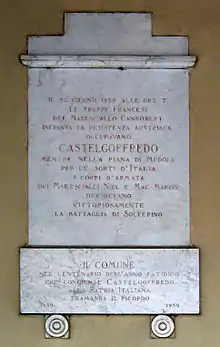
- Légion d'honneur :
- Médaille militaire (citation: the jewel of the Army)
- Commemorative medal of the 1859 Italian Campaign
- Knight Grand-Croix of the Order of the Bath (April 26, 1854)
- Crimea Medal
- Grand-Croix of the Order of the Elephant
- Knight of the Supreme Order of the Most Holy Annunciation (featured in the above portrait)
- Grand-Croix of the Military Order of Savoy (November 16, 1857)
- Sardinian Cross of Military Valor (1860)
- 1st Class Knight of the Order of the Medjidie
- Knight of the Order of St. Andrew
Armories
| Figure | Blasonnement |
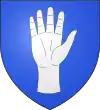 |
« On Blue Azure with a Silver Palmed Dexter Hand with Ancien Régime Knight Heraldry. » |
See also
Notes
- The Dean (French: Doyen) is most senior serving (oldest or responsible) and leading figure in a particular function of society (religious, education, diplomatical, governmental). In this case, the Dean is referring to de Canrobert, at the époque, as the most senior figure in the Marshal Corps of France.
- Departmental Archives of Lot en ligne, birth act 4 E 2214, vue 35/73.
- Pierre Milza, Napoléon III, Perrin, 2006, p.260
- Louis Girard, Napoléon III, Fayard, 1986. Re-edition : 2002. p.153
- Pierre Milza, Napoléon III, Perrin, 2006, p.261
- Pierre Milza, Napoléon III', Perrin, 2006, p.268
- Maurice Agulhon in 1848 ou l'apprentissage de la République 1848-1852, Paris, Le Seuil, 1973 p.235-236
- Victor Hugo, Choses vues, p. 379, Paris, editor Gallimard, folio, 1972, total pages 529, ISBN 2-07-036141-1
References
| Wikimedia Commons has media related to François Certain de Canrobert. |
 This article incorporates text from a publication now in the public domain: Chisholm, Hugh, ed. (1911). "Canrobert, François Certain". Encyclopædia Britannica (11th ed.). Cambridge University Press.
This article incorporates text from a publication now in the public domain: Chisholm, Hugh, ed. (1911). "Canrobert, François Certain". Encyclopædia Britannica (11th ed.). Cambridge University Press.
Biographies
- Germain Bapst, Le Maréchal Canrobert. Souvenirs d'un siècle (Marshal Canrobert. Souvenir of a century), Paris, Plon, 1899, 1902, 1904.